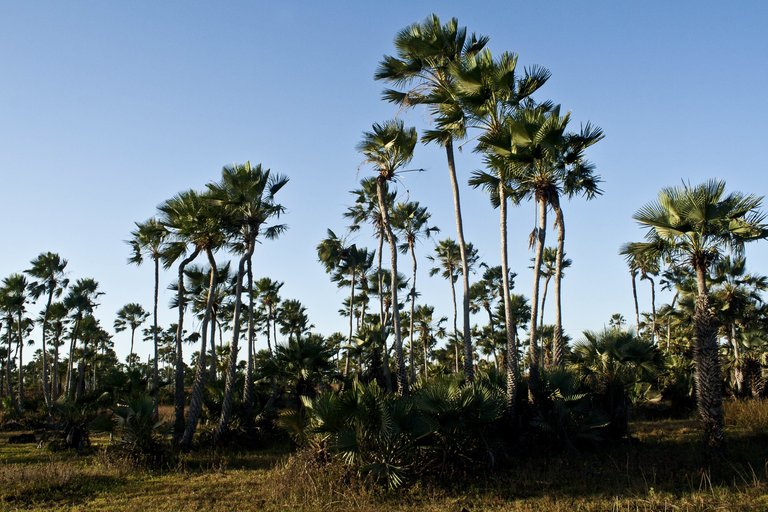JOIAS
From waxing your car to artisanal objects, an exploration of the Carnaúba palm, known as the tree of life!
JOIAS
Joias is the result of a residency of three Belgian designers and one Belgian curator who shared for three weeks life and work in a cute pink house in Santa Isabel, an island in the magisterial setting of the Brazilian Delta do Parnaíba.
Delta do Parnaíba
The Delta of Parnaíba is one of the three largest deltas in the world. Like the Nile and the Mekong River it has a unique ecosystem. Parnaíba is the entrance to this natural paradise.
Tree of life
The Carnaúba palm is also known as the ‘tree of life’. If you get to know the endless applications of the different parts of the palm, you immediately understand this nickname. Even in periods of drought, the tree survives without problems.
Environmental vital
The tree plays an important economic role in the North-East of Brazil. That’s why it appears on the flag of the states Rio Grande do Norte and Ceará. The most important economic uses are the powder to make the wax and the shredded straw – a bagana – that is used for the fertilisation and cooling of the ground of new plantations. Thanks to this protection the ground stays humid – even during the six dry summer months – and the temperature is more balanced, but it also protects the plants to heavy rainfalls.
From tree to object
Sun dried fibres of the Carnaúba tree form the basics to create high quality crafted objects. The fibres can be dyed or used naturally. Different techniques, handlings and processing result in an endless amount of both functional and decorative objects. The natural fibres of the palm tree are connected to each other using techniques such as ‘ponto aberto’ and ‘ponto fechado’ without the addition of other materials.
Our ‘joias’ are the fruit of a co-creation process between the artisans of Santa Isabel do Parnaíba and three Belgian designers. They are inspired by this overwhelming environment, and they are made out of the sun-dried fibres of the Carnaúba tree. In the six Joias collections the artistic concepts of the designers beautifully merge with the diverse craft techniques of the artisans.
(More on www.joias.be)








Elien Haentjens
As a freelance journalist Elien Haentjens (*1983, lives and works in Brussels) specializes since 2006 in the fields of design and art. Doing so, she further develops the expertise she gained during her studies Art History at KU Leuven. The exhibitions she has been curating around Belgian design in Brazil since 2013 are also in line with this. While she selected and showed finished pieces at first, she decided to intensify the Belgian-Brazilian dialogue by inviting Belgian designers to work with Brazilian artisans. Through design and art she wants to make people confident enough to open up for the other. This way she wants to stimulate the global dialogue, and at the same time ensure that people don’t lose their own identity and local culture.
In 2016 Elien Haentjens invited Livable founder Sep Verboom as the first designer to join her new concept. As they both liked the cooperation, she invited him another time in 2017, this time together with designers Linde Freya and Laura Caroen. To realise both projects Elien Haentjens worked closely together with two Brazilian partners.

Artesol
Artesol, a non-governmental organization established in 1998, with the purpose of supporting the safeguard and development of traditional arts and crafts in Brazilian localities with low HDI (human development index). In sixteen years of work, ArteSol has developed more than hundred projects in seventeen out of the twenty-six Brazilian states.
These projects have benefited more than twenty thousand people and respective families, including producers of ceramic, weaving, lace ,embroideries, sculpture, musical instruments, toys and other traditional handicrafts.

MADE
MADE - Mercado ArteDesign - is an international exhibition of collectible design. A platform to discuss, appreciate and buy the best of design, from vintage to contemporary.
MADE's proposal is to bring together quality content through exhibitions and installations, renowned design galleries and a collective space that exposes and highlights national and international designers and studios, revealing new talents, encouraging new productions and , Consequently, the expansion of design culture to thousands of people.
In addition to presenting the latest high-end design productions and encouraging business, the MADE platform aims to disseminate education and culture in the industry through a programming of design forums.
MADE is realized by the W / Design, of Waldick Jatobá, idealizer and general director of the event, that counts on the curation of Bruno Simões.

Sep Verboom
The Belgian creative Sep Verboom (1990) is at once designer and social entrepreneur, less concerned with the objectification of the result, more with the context in which it takes place.
‘Too often we measure success and profit in terms of economic values. What happened to the importance of people’s well-being and health of our environment?’
Through his Livable® platform, Verboom brings together partners as diverse as their geographies: from the Peruvian Amazon to Indonesia, and from local governments or commercial companies to NGO’s.
Verboom graduated with a degree in Industrial Design (HOWEST) and in Sustainable Development from (VIVES) both in Kortrijk (BE).
His collaborative approach has been internationally recognised, with numerous expositions and awards. In 2018 Sep Verboom won the Belgian Henry Van De Velde Award for Young Talent. In 2020 his commitment to socially engaged design earned him the prestigious title ‘Designer of the Year’ by Biennale Interieur.

Linde Freya
Within the works of Destroyers/Builders an interaction between the furniture pieces exist in an overarching inspiration; found in architectural elements, materials or building techniques. Linde Freya Tangelder, founder of the studio, strives for sensory relevance and cultural value in detail and larger scale. The works have a sculptural and architectural character, and balance between contemporary and traditional elements.
www.destroyersbuilders.com

Laura Caroen
Trained as a textile designer Laura Caroen (°1989, works in Ghent) is passionate about materials as such, and in particular about natural or recycled flexible fibres. In order to fully understand these materials she explores them to the core. This process of unravelling features the first phase of Caroen’s design process. With this primordial material she experiments in a search for new techniques, possibilities and functions.
In a second phase she looks for solutions such as weaving, braiding and knotting to reconnect the fibres. To get inspired Caroen likes to travel to countries such as Brazil, which are a treasury for natural materials and traditional craft techniques. As she’s very conscious about the value of materials herself, she loves to use recycled materials and to work with communities that attach importance to their raw materials. Moreover she loves participative collaborations and cross-pollination. Although Caroen positions herself in between art and design, she integrates more and more function into her installations.
www.lauracaroen.be

Elien Haentjens
As a freelance journalist Elien Haentjens (*1983, lives and works in Brussels) specializes since 2006 in the fields of design and art. Doing so, she further develops the expertise she gained during her studies Art History at KU Leuven. The exhibitions she has been curating around Belgian design in Brazil since 2013 are also in line with this. While she selected and showed finished pieces at first, she decided to intensify the Belgian-Brazilian dialogue by inviting Belgian designers to work with Brazilian artisans. Through design and art she wants to make people confident enough to open up for the other. This way she wants to stimulate the global dialogue, and at the same time ensure that people don’t lose their own identity and local culture.
In 2016 Elien Haentjens invited Livable founder Sep Verboom as the first designer to join her new concept. As they both liked the cooperation, she invited him another time in 2017, this time together with designers Linde Freya and Laura Caroen. To realise both projects Elien Haentjens worked closely together with two Brazilian partners.